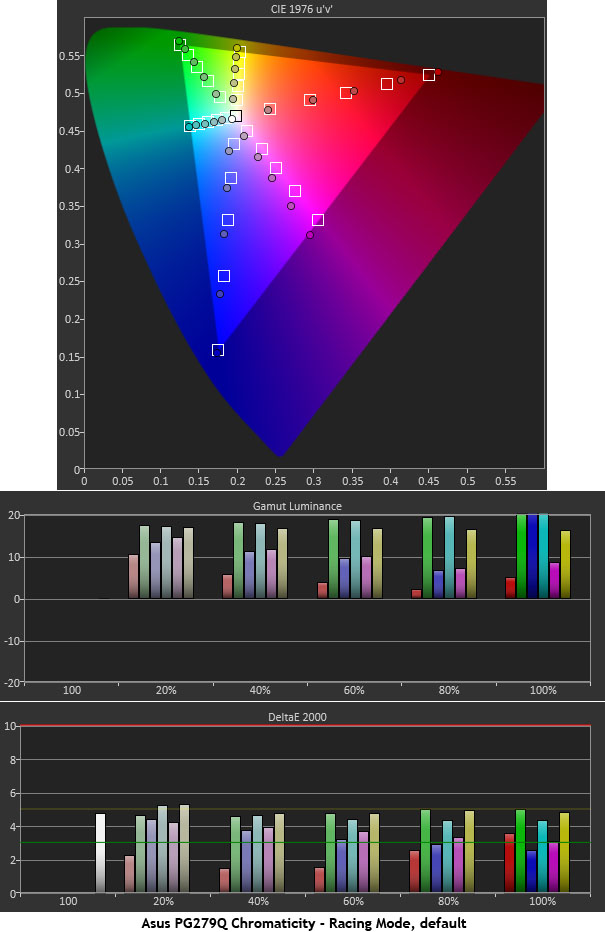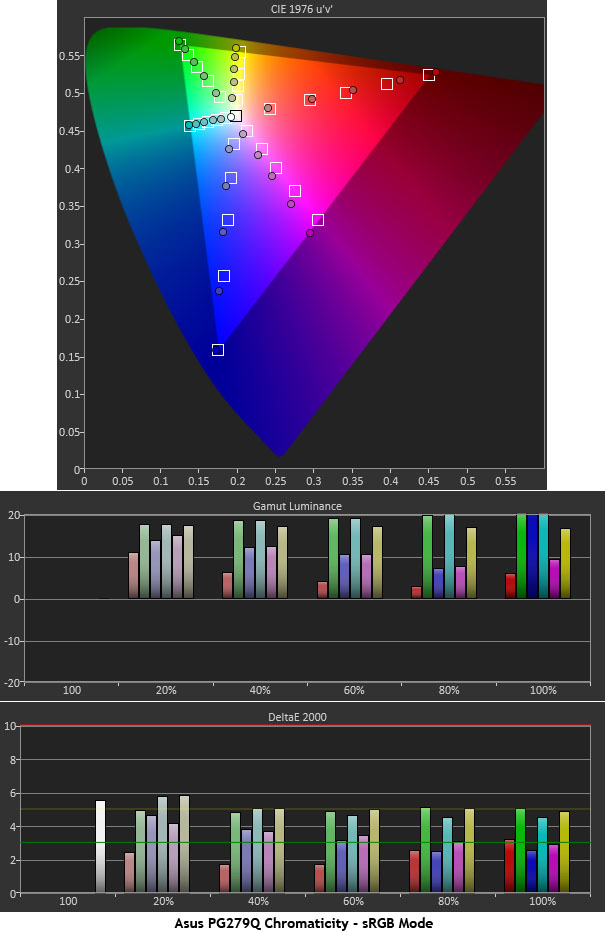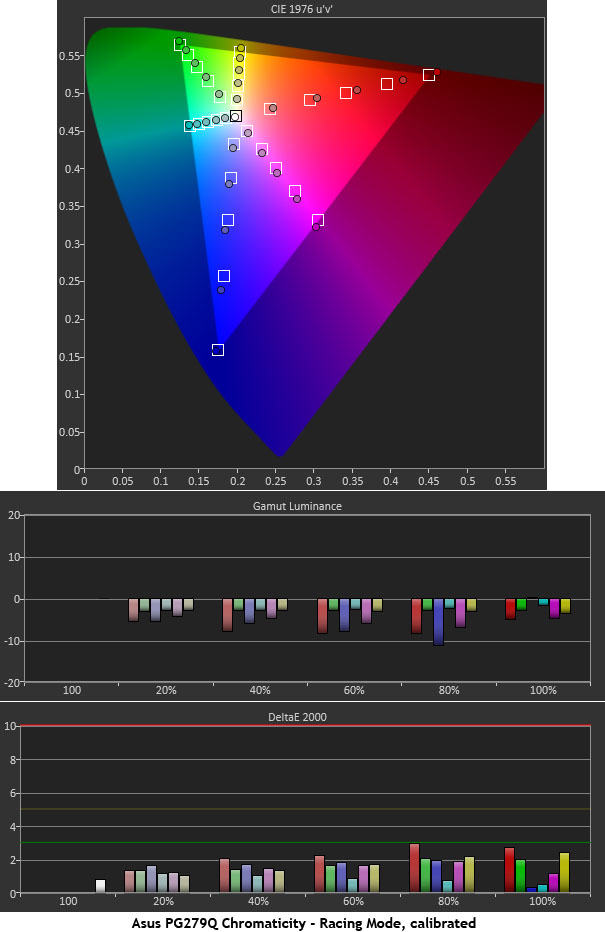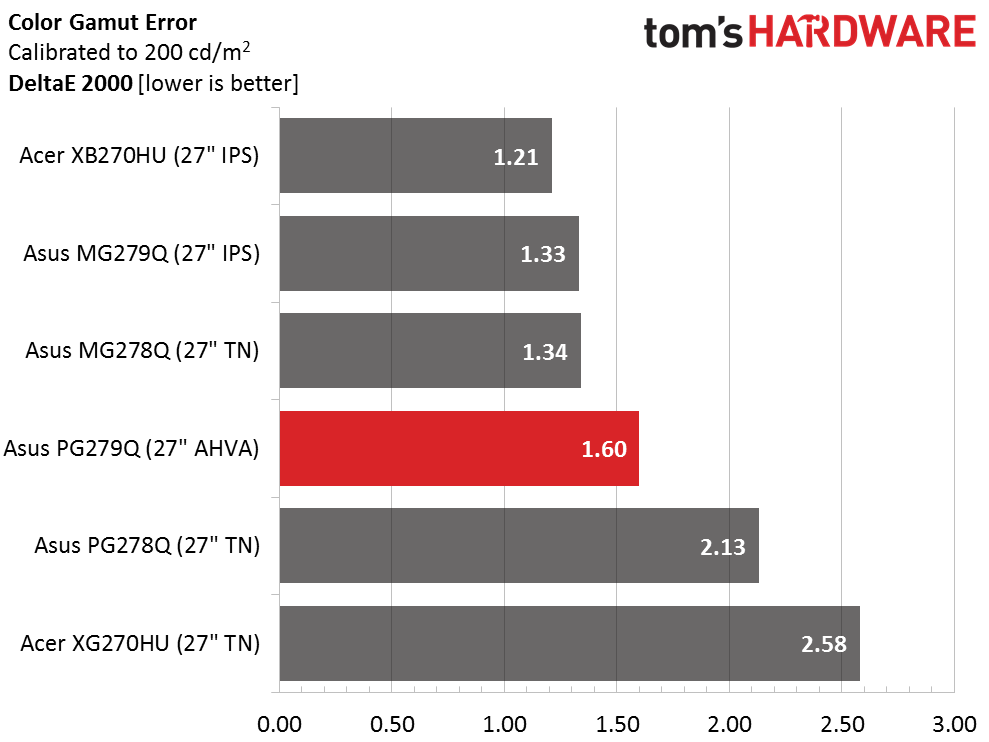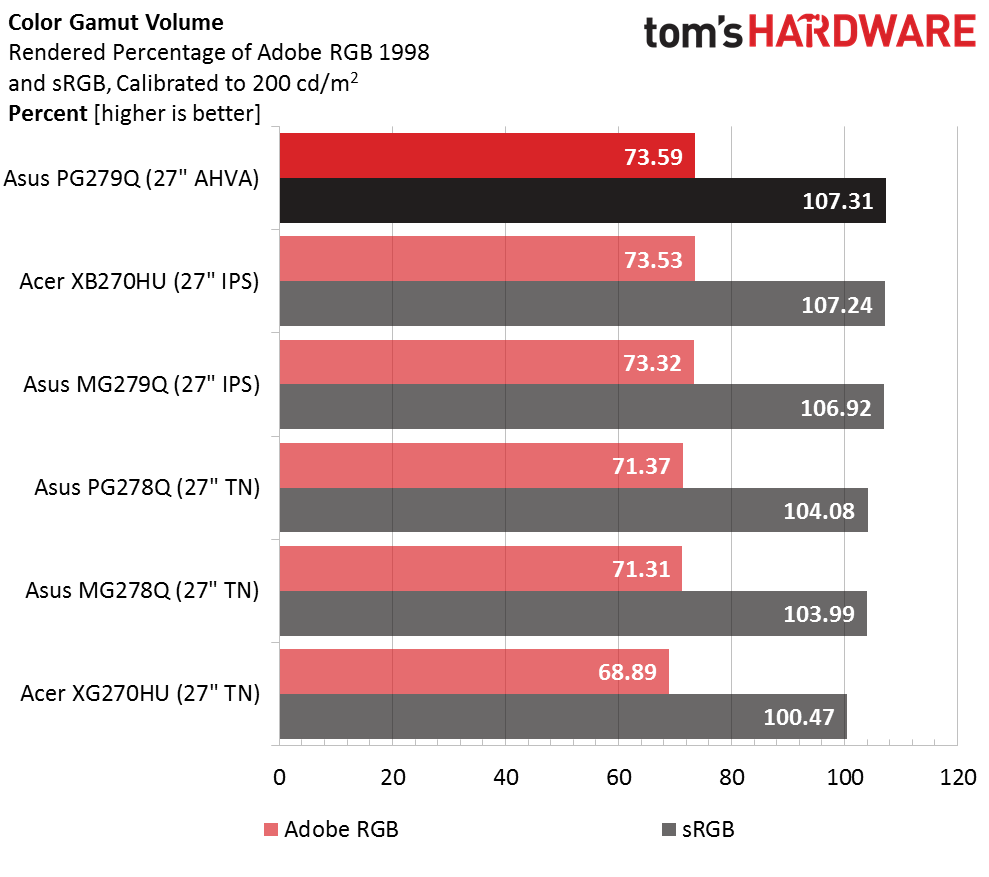Asus PG279Q ROG Swift 27-inch 165Hz Gaming Monitor Review
We have the highly-anticipated ROG Swift PG279Q in the lab today. It’s a 27-inch IPS-type panel with QHD resolution, G-Sync, ULMB and an unprecedented 165Hz max refresh rate.
Why you can trust Tom's Hardware
Color Gamut And Performance
For details on our color gamut testing and volume calculations, please click here.
The out-of-box errors in grayscale and gamma have a negative effect on color accuracy. You can see over-saturation in red and blue while magenta shows a hue error. Color luminances are also unbalanced, which creates problems in the very-familiar flesh and sky tones. You can see in the Delta E chart that almost every color and saturation point has a visible error.
sRGB is much the same as Racing so you won't be able to turn to it if accuracy is important. We understand most users don't have the means to calibrate but our settings will improve upon the PG279Q's default state.
There's no color management system available here but it seems that fixing the white point and contrast settings has done the trick. Blue and red are still over-saturated but their luminance levels are now lower, which fixes the problem. Now there are no visible color errors at any saturation level. This is excellent performance.
Now we return to the comparison group.
Many users feel that color accuracy isn't important for gaming but we disagree. Most titles are film-like in their graphics so if one is to fully experience a virtual world, it should look natural—as it would on a high-end HDTV. Over-blown hues only serve to mask fine detail. A color-accurate QHD monitor will trump an inaccurate UHD one all day long. The PH279Q is solidly in the middle of a good group of displays. With our recommended adjustments, any user would be more than satisfied with its color.
Gamut Volume: Adobe RGB 1998 And sRGB
The ROG Swift has one of the largest sRGB gamut volumes we've measured. Tweaked luminance levels keep color from becoming cartoonish but to take advantage of its bonus blue and red, you just need a software look-up table running. It's nice to see that none of our group of premium displays gives any color away. They all exceed 100 percent sRGB.
Get Tom's Hardware's best news and in-depth reviews, straight to your inbox.
Current page: Color Gamut And Performance
Prev Page Grayscale Tracking And Gamma Response Next Page Viewing Angles, Uniformity, Response And Lag
Christian Eberle is a Contributing Editor for Tom's Hardware US. He's a veteran reviewer of A/V equipment, specializing in monitors. Christian began his obsession with tech when he built his first PC in 1991, a 286 running DOS 3.0 at a blazing 12MHz. In 2006, he undertook training from the Imaging Science Foundation in video calibration and testing and thus started a passion for precise imaging that persists to this day. He is also a professional musician with a degree from the New England Conservatory as a classical bassoonist which he used to good effect as a performer with the West Point Army Band from 1987 to 2013. He enjoys watching movies and listening to high-end audio in his custom-built home theater and can be seen riding trails near his home on a race-ready ICE VTX recumbent trike. Christian enjoys the endless summer in Florida where he lives with his wife and Chihuahua and plays with orchestras around the state.
-
TechyInAZ That is one sweet monitor! I can't imagine how good the OLED versions will be. : )Reply
It's interesting to note that this monitor is actually more demanding than a 4k 60hz monitor. Even though this is only a 2k monitor, it actually has nearly 3x the Hz compared to it's 4k counterparts, making it not supprising that you need at least dual GTX 980tis/Titan Xes to run everything at good settings. -
Epsilon_0EVP This isn't the first 165Hz+ monitor. Plenty of CRT's could achieve around 200Hz at low resolutions, and that was over 10 years ago.Reply -
Uri___Pisarev I don't know, i went from a 32 inch TV to a 34 inch ultra wide Dell. I feel like i can still use a bigger monitor, anything sub 30 is just too small.Reply -
ubercake What I like about these G-sync monitors is you don't have to use an SLI setup to push maximum framerates to minimize perceivable tearing. Ever since the GTX 980 and the Asus PG278Q, all I've needed for great smooth video performance is a G-sync monitor and a single video card. I don't need 165Hz/165fps. I just need smooth gaming through the gamut of my GTX 980's performance whether the framerates are in the 30s or 100s, it's still smooth; no tearing. This G-sync is great tech.Reply
Now add the PG279Q's fast IPS performance and better contrast to the mix and it seems like an intriguing proposition... -
Robert Dunlop I bought the Acer XB27HU with 165hz and what l wasn't prepared for was how fun these types of monitors make playing games again.Reply
The reviewer is spot on. -
Uri___Pisarev ReplyThat is one sweet monitor! I can't imagine how good the OLED versions will be. : )
It's interesting to note that this monitor is actually more demanding than a 4k 60hz monitor. Even though this is only a 2k monitor, it actually has nearly 3x the Hz compared to it's 4k counterparts, making it not supprising that you need at least dual GTX 980tis/Titan Xes to run everything at good settings.
So you need to spend over 2K to really enjoy the product? That's insane to be honest. If you are a regular person out there and all you are willing to spend is $200 on the card (most common option that people chose) that means you will be able to buy that card and fully maxout this monitor oh in about 7 years or so, that's how long it will take for a GTX960 equivalent to be as powerful as 2 980ti's.
-
TechyInAZ Reply17546502 said:That is one sweet monitor! I can't imagine how good the OLED versions will be. : )
It's interesting to note that this monitor is actually more demanding than a 4k 60hz monitor. Even though this is only a 2k monitor, it actually has nearly 3x the Hz compared to it's 4k counterparts, making it not supprising that you need at least dual GTX 980tis/Titan Xes to run everything at good settings.
So you need to spend over 2K to really enjoy the product? That's insane to be honest. If you are a regular person out there and all you are willing to spend is $200 on the card (most common option that people chose) that means you will be able to buy that card and fully maxout this monitor oh in about 7 years or so, that's how long it will take for a GTX960 equivalent to be as powerful as 2 980ti's.
G sync will help with that.
Plus, like the reviewer said, this monitor is has future proofing in mind. It's designed for future cards that can handle this kind of product. -
toddybody I sold my G-Sync 4K panel for a DELL 2716DG (27"@1440p G-Sync 144hz)...90fps has become the new 60fps for me. Can't tell folks how huge it is to go past 60hz.Reply -
agentsi1511 ReplyThat is one sweet monitor! I can't imagine how good the OLED versions will be. : )
It's interesting to note that this monitor is actually more demanding than a 4k 60hz monitor. Even though this is only a 2k monitor, it actually has nearly 3x the Hz compared to it's 4k counterparts, making it not supprising that you need at least dual GTX 980tis/Titan Xes to run everything at good settings.
This is totally wrong, don't mislead people researching things. I have the Acer XB270HU and run everything at max settings on single GTX 970. IT is not more demanding than a 4k monitor in anyway. As someone with Techy in their name I would imagine you had a clue about this. -
TechyInAZ Reply17546521 said:That is one sweet monitor! I can't imagine how good the OLED versions will be. : )
It's interesting to note that this monitor is actually more demanding than a 4k 60hz monitor. Even though this is only a 2k monitor, it actually has nearly 3x the Hz compared to it's 4k counterparts, making it not supprising that you need at least dual GTX 980tis/Titan Xes to run everything at good settings.
This is totally wrong, don't mislead people researching things. I have the Acer XB270HU and run everything at max settings on single GTX 970. IT is not more demanding than a 4k monitor in anyway. As someone with Techy in their name I would imagine you had a clue about this.
What games do you play?
